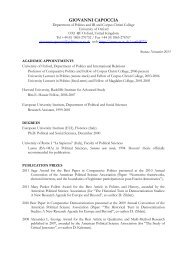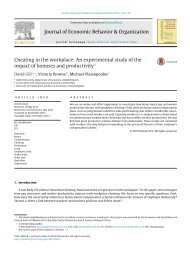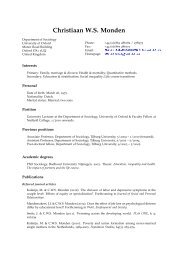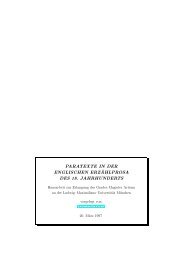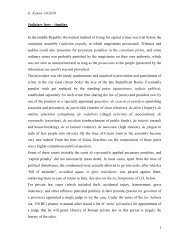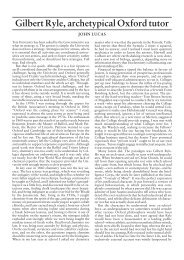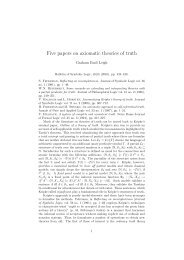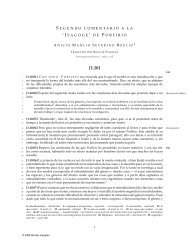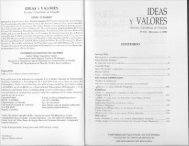Lexical Functional Grammar - Personal Pages Index
Lexical Functional Grammar - Personal Pages Index
Lexical Functional Grammar - Personal Pages Index
You also want an ePaper? Increase the reach of your titles
YUMPU automatically turns print PDFs into web optimized ePapers that Google loves.
must obtain a meaning for its arguments in order for a meaning for the sentence<br />
to be available.<br />
The f-structure for the sentence David yawned, together with the instantiated<br />
meaning constructors contributed by David and yawned, is given in (49):<br />
(49)<br />
⎡<br />
⎤<br />
PRED ‘YAWN〈SUBJ〉’<br />
y : ⎣<br />
SUBJ d : [ PRED ‘DAVID’ ] ⎦<br />
[David]<br />
David : d σ<br />
[yawn] λX.yawn(X) : d σ −◦ y σ<br />
The left-hand side of the meaning constructor labeled [David] is the proper<br />
noun meaning David, and the left-hand side of the meaning constructor labeled<br />
[yawn] is the meaning of the intransitive verb yawned, the one-place predicate<br />
λX.yawn(X).<br />
We must also provide rules for how the right-hand (glue) side of each of<br />
the meaning constructors in (49) relates to the left-hand (meaning) side in<br />
a meaning deduction. For simple, nonimplicational meaning constructors like<br />
[David] in (49), the meaning on the left-hand side is the meaning of the semantic<br />
structure on the right-hand side. For meaning constructors which contain<br />
the linear implication operator −◦, like [yawn], modus ponens on the glue side<br />
corresponds to function application on the meaning side:<br />
(50) X : f σ<br />
P : f σ −◦ g σ<br />
P(X) : g σ<br />
With these correspondences between linear logic formulas and meanings, we<br />
perform the following series of reasoning steps:<br />
(51) David : d σ The meaning David is associated with the<br />
SUBJ semantic structure d σ .<br />
λX.yawn(X) : d σ −◦ y σ<br />
On the glue side, if we find a semantic resource<br />
for the SUBJ d σ , we consume that<br />
resource and produce a semantic resource<br />
for the full sentence y σ . On the meaning<br />
side, we apply the function λX.yawn(X)<br />
to the meaning associated with d σ .<br />
yawn(David) : y σ<br />
We have produced a semantic structure<br />
for the full sentence y σ , associated with<br />
the meaning yawn(David).<br />
By using the function application rule and the meaning constructors for David<br />
andyawned, wededucethemeaningyawn(David)forthesentenceDavidyawned,<br />
as desired.<br />
21



